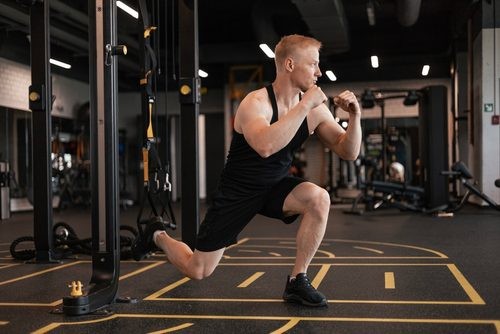28 de March de 2025
Strength and Conditioning Program for Soccer
Soccer is one of the most physically demanding sports in the world, requiring a unique combination of endurance, strength, speed, and agility. Elite soccer players must possess the physical tools to dominate on the pitch, sustain high-intensity efforts, and recover quickly.
A well-structured Strength and Conditioning (S&C) program tailored to soccer players is essential to elevate performance and reduce the risk of injury. As an elite professional soccer coach, I understand the importance of designing programs that meet the unique demands of the sport while aligning with the player’s position and team strategy.
Why Strength and Conditioning is Critical for Soccer
Soccer is a multi-faceted sport with physical demands that vary depending on position and style of play. Here are the key physical attributes a soccer player must optimize through S&C:
- Endurance: Players cover an average of 6-9 miles per game, requiring exceptional aerobic and anaerobic fitness.
- Explosive Power: Sprinting, jumping, and striking require explosive strength.
- Agility and Quickness: Rapid changes of direction are crucial for defensive moves and attacking runs.
- Strength: Strong legs and core muscles support balance, stability, and powerful strikes.
- Injury Prevention: Soccer players are prone to hamstring strains, ACL injuries, and ankle sprains, making prehabilitation critical.
A soccer-specific S&C program develops these attributes, ensuring players are physically prepared to excel in training and competition.

Principles of Soccer Strength and Conditioning
Designing an effective S&C program for soccer requires adherence to several core principles:
- Position-Specific Training: Defenders, midfielders, forwards, and goalkeepers have distinct physical demands. Programs must reflect these roles.
- Periodization: Training must be structured into phases (off-season, pre-season, and in-season) to maximize performance and recovery.
- Progressive Overload: Gradual increases in training intensity ensure continuous improvements in strength, endurance, and power.
- Recovery and Mobility: Stretching, foam rolling, and rest days are critical to prevent overuse injuries and optimize recovery.
- Sport-Specific Movements: Exercises should replicate the movements of soccer, such as lateral agility, rotational power, and sprint mechanics.
Soccer-Specific Strength and Conditioning Techniques
A soccer-specific S&C program emphasizes the following components:
- Lower Body Strength and Power: Builds the foundation for explosive sprints, powerful shots, and strong tackles. Examples: Bulgarian split squats, trap bar deadlifts, and single-leg Romanian deadlifts.
- Core Stability and Rotational Power: Crucial for balance, agility, and striking power.Examples: Medicine ball rotational throws, Pallof presses, and hanging leg raises.
- Speed and Agility: Enhances acceleration, deceleration, and lateral quickness. Examples: Sprint intervals, zig-zag cone drills, and agility ladder patterns.
- Endurance Conditioning: Builds the stamina required for 90-minute matches. Examples: Tempo runs, shuttle sprints, and small-sided games.
By integrating these techniques, players can enhance their performance and physical resilience.
Soccer Strength and Conditioning Program
A professional soccer S&C program should adapt to the phases of the season. Below is a detailed breakdown for off-season, pre-season, and in-season training.
Off-Season Soccer S&C Program
The off-season focuses on building foundational strength, addressing weaknesses, and improving mobility. This phase prepares players for the higher intensity of pre-season training.

Weekly Breakdown (8-12 Weeks)
Day 1: Strength Development
- Trap Bar Deadlifts: 4×6 reps.
- Bulgarian Split Squats: 4×10 reps per leg.
- Pull-Ups: 3×8-10 reps.
- Plank Variations (Front and Side): 4×30-45 seconds.
- Mobility Work: 10 minutes targeting hips and hamstrings.
Day 2: Speed and Power
- Resisted Sprints: 6×30 yards.
- Box Jumps: 4×6 reps.
- Medicine Ball Rotational Slams: 3×12 reps.
- Sprint Intervals: 5×40 yards with 90 seconds rest.
Day 3: Recovery
- Dynamic Stretching Routine: 15 minutes.
- Yoga for Athletes: 30 minutes.
- Foam Rolling: 10 minutes.
Day 4: Agility and Quickness
- Agility Ladder Drills: 5 rounds.
- Lateral Cone Drills: 5×20 seconds on, 40 seconds off.
- Bounding Drills: 4×8 reps.
Day 5: Endurance Conditioning
- Tempo Runs: 6×300 meters at 75% effort.
- Shuttle Sprints: 8×40 yards with 30 seconds rest.
Day 6: Core and Stability
- Anti-Rotation Pallof Press: 3×20 seconds per side.
- Hanging Windshield Wipers: 3×10 reps per side.
- Unstable Surface Planks with Ball Taps: 3×45 seconds.
Day 7: Rest
- Active recovery with light jogging or swimming.
Pre-Season Soccer S&C Program
The pre-season transitions foundational strength into soccer-specific performance, focusing on explosive power, agility, and endurance.
Weekly Breakdown (4-6 Weeks)
Day 1: Explosive Strength
- Front Squats: 4×6 reps.
- Medicine Ball Overhead Throws: 3×10 reps.
- Barbell Hip Thrusts: 4×8 reps.
Day 2: Agility and Decision-Making
- Zig-Zag Cone Drills: 6 rounds.
- Reaction Sprints: 5×15 yards triggered by external cues.
- Short-Distance Sprints: 5×20 meters.
Day 3: Active Recovery
- Foam Rolling: 10 minutes.
- Dynamic Yoga Flow: 20 minutes.
Day 4: Game Simulation and Power
- Depth Jumps: 4×6 reps.
- Rotational Medicine Ball Throws: 3×10 reps per side.
- Small-Sided Games: 4×4 minutes with 1-minute rest.
Day 5: Conditioning and Endurance
- Interval Runs: 6×400 meters at 80% effort with 2-minute rest.
- Simulated Game Scenarios: Incorporate sprints and deceleration drills.
Day 6: Stability and Rotation
- Cable Rotational Pulls: 3×12 reps per side.
- Single-Arm Landmine Presses: 3×10 reps.
Day 7: Rest
- Recovery through guided meditation or light walking.
Artículo relacionado: 11198
In-Season Soccer S&C Program
During the in-season, the focus shifts to maintaining strength, optimizing recovery, and ensuring players are match-ready.
Weekly Breakdown (12-16 Weeks)
Day 1: Maintenance Strength
- Trap Bar Deadlifts: 3×5 reps at 70% max.
- Incline Dumbbell Bench Press: 3×8 reps.
Day 2: Agility and Activation
- Short Cone Drills: 6 rounds.
- Reaction-Based Sprints: 5×30 yards.
- Broad Jumps: 3×8 reps.
Day 3: Recovery and Mobility
- Dynamic Yoga Flow: 20 minutes.
- Foam Rolling: 10 minutes.
Day 4: Power Refresh
- Medicine Ball Chest Throws: 3×12 reps.
- Single-Leg Step-Ups: 3×8 reps per leg.
Game Days
- Warm-Up: Arm swings, leg swings, and mobility drills.
Leveraging Velocity Based Training in Soccer
Velocity Based Training (VBT) offers unparalleled precision in optimizing soccer Strength and Conditioning (S&C) programs. With VBT devices, such as the Vitruve encoder, coaches can monitor bar speed and ensure players train within the correct velocity zones for their specific goals. By providing real-time feedback, VBT allows coaches to tailor training intensity to match the physical demands of each position and athlete.
For attackers, VBT focuses on explosive power, enhancing sprints and sharp directional changes crucial for offensive plays. Midfielders, who require a balance of speed and endurance, benefit from customized load adjustments to sustain high-intensity efforts throughout a match. Defenders rely on strength and reactive power, both of which can be optimized using VBT metrics to fine-tune exercises such as resisted sprints and depth jumps.

A significant advantage of VBT is its ability to prevent overtraining. By tracking athlete fatigue and velocity loss during sessions, coaches can adjust workloads dynamically, ensuring players recover adequately without compromising performance. This data-driven approach reduces injury risks and maintains optimal player readiness, especially during congested match schedules or tournament phases.
Moreover, VBT promotes individualized programming by identifying each athlete’s capabilities and training thresholds. By using tools like Vitruve Apps, coaches can easily access load-velocity profiles to track and adjust an athlete’s progress throughout the season
This precision ensures that no player is under-challenged or pushed beyond their limits, fostering steady progress and peak performance. For soccer teams aiming to stay competitive at the elite level, integrating Velocity Based Training into S&C programs is a game-changer, providing an edge in preparation and performance.

